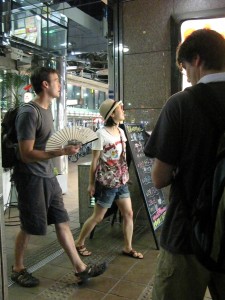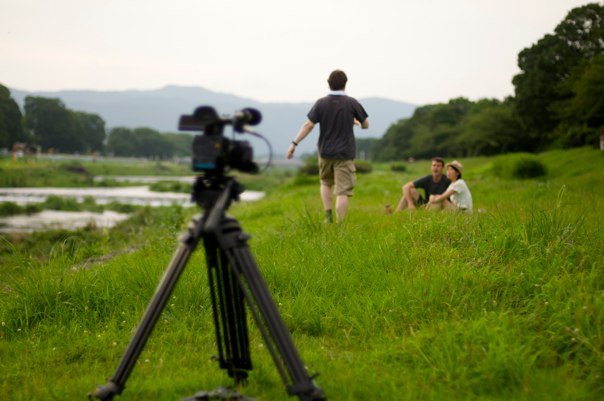http://www.deepkyoto.com/children-of-water/
"An Interview with film-makers Roger Walch and Ted Taylor
I love film-making… I love to think of
stories, to make a film, to edit a film, to put the sound track
together… And as soon as I’m finshed with a film. I want to do the next
one…
(Roger Walch)
Last week Ted Taylor invited me to dinner with the makers of the movie “Tengu” in the izakaya “Tengu” (do you see what they did there?). I spoke to Ted and to the director Roger Walch about their new film project: “Children of Water”. They had just completed a long day location shooting at Itami airport, the Kamo river, Yoshida yama, and in front of Tengu. Though tired, over a bite to eat and a few beers they waxed enthusiastic about their new movie. Roger explains the plot as follows:
After one year in an ESL-course in the US a Japanese graphic
designer returns to Japan and discovers that she is pregnant. She
contemplates abortion, but her American boyfriend strongly opposes and
flies to Japan to convince her to keep the baby. During his stay he not
only gets to know life and customs in Japan but also different moral and
religious values.
Ted: It’s a cross-cultural thing. He’s trying to
come back and save the relationship and he wants to have the kid, but
she thinks he comes to support her. She thinks he’s coming to be kind
like “oh I’m gonna come with you and be at your side while you have it”.
You know. Whereas, he’s coming to prevent her from having it and
convince her to come back to the US, she’s more businesslike about it,
Michael: She’s already decided?
Ted: She’s more black and white about it, right. And
he’s more like no, no, no! He’s there to keep the relationship alive and
she’s just dealing with the baby situation so again they’re not
communicating. Roger was saying first he was just gonna do rooms and
shooting in rooms, but now he wants to shoot a couple of days around
Kyoto because he said, well you know we should show some Kyoto… He is
using this as a platform to show more about Japanese culture – so things
related to children and the death of children like jizo [see note at end of article] and kokeshi…
Michael: Kokeshi?
Ted: Kokeshi is like – you know those kokeshi dolls.
Michael: Yeah. How do they relate to that?
Ted: Um, in particular up in Tohoku, in the old days
when farm families didn’t have enough, they would have an unwanted
child, and they couldn’t feed it and they would basically starve it to
death or kill it. They would get a kokeshi doll that would basically be a
representation like the spirit of the kokeshi doll is actually in…
Michael: That’s where kokeshi dolls come from? That’s horrific! I thought they were just like cute little dolls.
Ted: Yeah. Exactly and that’s the reaction I think. And
that’s why… the Tohoku region is basically putting the kabash on that,
they are really keeping that fact underground now because kokeshi dolls
are considered a folk art for that region. A lot of tourism is based on
people buying that as omiyage. So were people to know these represent
the spirit of a child, people would not be buying these things… “Ko” [子]
is child and “keshi”is like kesu [消す].
Roger: Kesu. Like “erase a child”.
Michael: It gets creepier every time you talk about it!
Roger: You can hardly find any reference to it on the internet because in northern Japan they are now –
Michael: How did you find out about it?
Roger: It’s just logic. You look at the name. The Japanese characters.
Michael: But to find out that that’s what it was for you must have done some research.
Roger: Some Japanese told me and … it’s like the ubasuteyamas [姥捨], you know. Where you throw away your grandmother in the mountains…
Michael: There was a short story…
Roger: Yeah, Narayama Bushiko “The Ballad of Narayama”.
Ted: It’s a brilliant film. Have you seen it? I’ll give you a copy…
Roger: There’s two films, a black and white film and the remake by Imamura Shohei
in 1983. And that’s a very good movie. I think it’s one of my favorite
movies. It’s about when the old men, old women reach the age of 70 they
have to make space for the young generation.
Ted: Like Logan’s Run?
Michael: I was just about to say that! (laughs)
Roger: Kokeshi is a little bit like this ubasuteyama.
You know in Japan, until 100 years ago to kill your own child was not a
big deal or a big sin. It’s just if you couldn’t feed them… The same
happened in Europe.
Michael: There was a lot of rural poverty wasn’t there?
Roger: Yeah poverty and especially in the countryside,
if you live in a valley and in long winters… so that’s one explanation
of the kokeshi. Of course the officials of Yamagata and Akita will not
admit it. Kokeshi are a big export. …A good friend of mine, a French guy
who lived in Kyoto, his name is Eric Faure
and he wrote three books on Japanese cults and demons and spirits so
he’s an absolute specialist on Japanese ghosts and demons and myths and
legends and everything and I talked to him about kokeshi too. I brought
up the topic and I said I need a kokeshi doll as a prop for my movie and
he said never ever get a kokeshi doll at an antique store, he really
urged me never ever get a kokeshi doll at an antique store, never ever
get a second hand kokeshi doll because it could be possessed by the soul
of a child.
Ted: If they were new they would be fine because they
are technically pure but if you were to buy them at an antique shop you
are technically buying a fetish item that has the spirit of a child in
it.
Michael: Eek!
Ted: Yeah. It’s like Chucky yeah.
Roger: There is a famous temple in Kyoto, not far from Horikawa/Imadegawa and it’s the doll’s temple.
It’s where you bring your possessed doll! It’s a little bit north-east
of Imadegawa/Horikawa. The temple is run by nuns, and there are dolls
with growing hair… behaving strangely . If you have a doll that is
possessed they do the exorcism and they destroy it for you.
Ted: So we’re using the film as a springboard for that,
this fantastic, supernatural element of Japan, but it’s not so overt
like the whole Tengu naked kitsune thing. It’s more like this is just part of the culture…

[Roger and Ted co-wrote the script for “Children of Water”. I asked Roger about the script writing process…]
Roger: I outlined the script and I wrote some basic
dialogues, or my ideas for dialogues… he [Ted] kind of works them out
and puts them in his words… a little bit more eloquently than my
English. Basically I laid down the story…
Ted: I do have to say, if you’ll allow me to be
immodest for a minute, I tried to write an emotionally powerful scene
without having a whole lot of faith in it. But then when we acted it, it
was quite powerful. I got kind of emotional and there was a great sense
of anger in both of us… I could feel it building in me as we were
acting so that was really cool. I mean again you know I’m not an actor, I
don’t know what to do as an actor but to be able to create an emotion
out of nothing, for the first time to ever do that, it was like wow – we
actually acted. She and I, neither of us are pros but it was
like wow we actually created emotion. And Roger said he was watching the
dailies that night and he said yeah it was really good. The words were
good. The way we conveyed the words were good. So I was really happy.
And I told Roger that. My words are my strength not my acting. I have
more faith in what I write. That’s why I’m happy to write. Because when
we are saying the words later, when we are filming it I can feel more
confident in what I’m doing when I try to convey these words.
Michael: So when will the film be finished and ready to show?
Roger: That’s a good question. A very good question. We
will have to finish shooting with Ted by the 4th of August because we
leave for Switzerland on the 5th. And then Ted will be gone. You know he
leaves in September. So in September we will do some location shots or
just her alone. I’ll do some things in September. Then editing and
everything, post production, probably end of the year, beginning of next
year.
Michael: And distribution?
Roger: Yeah! Always the question. Showings are still undiscussed. (laughs)
“Tengu”,
is generating some interest… we show it here and there. I had screenings
in Tokyo and Nagoya and I’ll show it in Switzerland in August, and…
Ted: Bringing it to New Mexico next year…
Roger: Yeah right, and I’ll show it in Tokyo again in
October and December… I’ll send it to festivals and everything but there
is no distributor. …It’s a short film and it’s a very current theme so
it’s easy to send to short film festivals. The problem is I love
film-making but I’m not a business man, I love to think of stories, to
make a film, to edit a film, to put the sound track together…
Michael: But actually selling it is a weak point?
Roger: Yeah, totally, totally, totally. I’m totally not interested in that at all. So what I need is a producer..
Michael: A Brian Epstein?
Ted: Yes, yes yes. A Colonel Parker.
Roger: And as soon as I’m finished with a film. I want
to do the next one. I don’t want to sit back for two years sending it to
all the festivals – it bores me to death!
Note: Jizo or Ojizosama is a kind of Buddhist saint, considered to be the patron of children, particularly those who die young. His statue can be seen everywhere in Japan, by the roadside, in temples, shrines, up a mountain or in a forest. Often he is dressed in a red bib or decorated with childrens’ toys to make his appearance less fearsome to the spirits of the children he will guide into the afterlife. More recently in Japan he has been worshipped as the guardian of the souls of stillborn, miscarried or aborted fetuses. These are known as 水子 “mizuko” or “children of water“.
You can see trailers for Roger’s previous body of filmwork on his website here: rowmusefilms.com. Roger is also an accomplished musician. He writes his own soundtrack music and performs regularly as a pianist with a shakuhachi player, percussionist and trombone player. You can see some of his musical work here: shakuhachipiano."


No comments:
Post a Comment